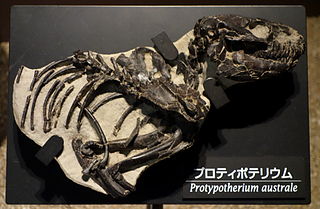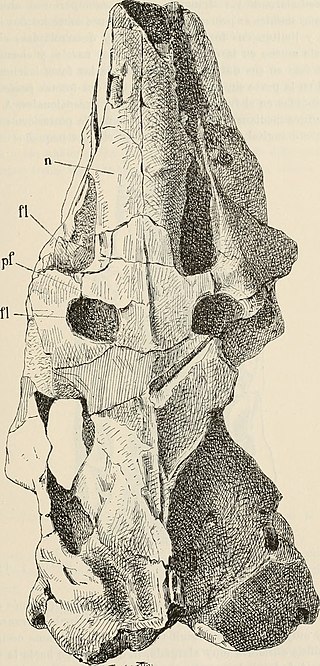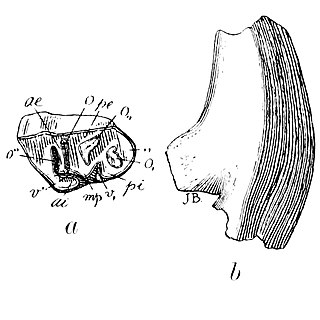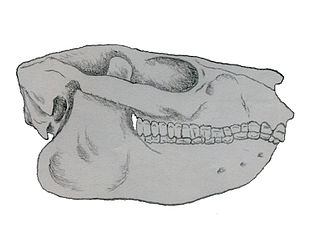Description
This animal was vaguely similar to a wombat, and its dimensions evocate those of a raccoon ; its skull was approximately 16 centimeters long, while its total length, excluding the tail, was about 80 centimeters. It weighed around 10 kilograms.
Altitypotherium had a tall and narrow snout, with only six pairs of teeth in the maxilla and mandible, a low number when compared to most other notoungulates. It had gliriform upper incisors, with a band of anterior enamel, and lower incisors protruding forward and separated from premolars and molars by a long diastema. It had high-crowned (hypsodont) teeth, and the occlusal surfaces of the molars had two enamel folds halfway through the tooth in the inner surface and outlining three dentin-filled lobes, forming an E-shaped form. The largest species, Altitypotherium paucidens was distinguished from its closest relatives by the loss of the upper third molar.
Classification
The genus Altitypotherium was first described in 2004, based on fossil remains found in the Chucal Formation in Northern Chile, in Early Miocene terrains ; two species are currently known, A. chucalensis and A. paucidens. Fossils attributed, with some uncertainty, to the genus have also been found in Argentina.
Altitypotherium belonged to the family Mesotheriidae, a group of typotheres that diversified during the Cenozoic, giving rise to forms the size of a ram. Altitypotherium belonged to the subfamily Mesotheriinae, the most derived clade of the group.

Pyrotherium is an extinct genus of South American ungulate, of the order Pyrotheria, that lived in what is now Argentina and Bolivia, during the Late Oligocene. It was named Pyrotherium because the first specimens were excavated from an ancient volcanic ash deposit. Fossils of the genus have been found in the Deseado and Sarmiento Formations of Argentina and the Salla Formation of Bolivia.

Protypotherium is an extinct genus of notoungulate mammals native to South America during the Oligocene and Miocene epochs. A number of closely related animals date back further, to the Eocene. Fossils of Protypotherium have been found in the Deseadan Fray Bentos Formation of Uruguay, Muyu Huasi and Nazareno Formations of Bolivia, Cura-Mallín and Río Frías Formations of Chile, and Santa Cruz, Salicas, Ituzaingó, Aisol, Cerro Azul, Cerro Bandera, Cerro Boleadoras, Chichinales, Sarmiento and Collón Curá Formations of Argentina.

Mesotheriidae is an extinct family of notoungulate mammals known from the Oligocene through the Pleistocene of South America. Mesotheriids were small to medium-sized herbivorous mammals adapted for digging.

Nesodon is a genus of Miocene mammal belonging to the extinct order Notoungulata which inhabited southern South America during the Late Oligocene to Miocene living from 29.0 to 16.3 Ma and existed for approximately 12.7 million years. It had a relatively large size, weighing up to 554 kg (1221 lbs) and reaching 1.5 m in height.

Paedotherium is an extinct, potentially paraphyletic genus of Notoungulate, belonging to the family Hegetotheriidae, composed of small-sized, rodent or lagomorph-like South American ungulates. Four species are unambiguously recognized, from the Late Miocene to the Pleistocene of Argentina, and from the late Miocene of Bolivia and Chile.
Otrhonia is an extinct genus of notoungulate, belonging to the Notostylopidae family. It lived during the Late Eocene, and its remains were discovered in South America.
Ethegotherium is an extinct genus of Notoungulates, belonging to the suborder Typotheria. It lived from the Lower to the Middle Miocene, and its fossilized remains were discovered in South America. It might be a synonym of the genus Prohegetotherium.
Pseudhyrax is an extinct genus of archaeohyracid notoungulate. It lived from the Late Eocene to the Early Oligocene, of what is now South America.

Hemihegetotherium is an extinct genus of hegetotheriid notoungulate that lived from the Middle to the Late Miocene of what is now Argentina.

Argyrohippus is an extinct genus of notoungulate, belonging to the family Notohippidae. It lived from the Late Oligocene to the Early Miocene, and its fossilized remains were found in South America.

Trachytherus is an extinct genus of mesotheriid notoungulate that lived from the Late Oligocene to the Early Miocene in what is now South America.

Eomorphippus is an extinct genus of notohippid notoungulate that lived from the Late Eocene to the Early Oligocene in what is today South America.
Anayatherium is an extinct genus of notoungulate belonging to the family Leontiniidae. It lived during the Late Oligocene, and its fossilized remains were discovered in South America.
Coquenia is an extinct genus of Notoungulate, belonging to the family Leontiniidae. It lived during the Middle Eocene, in what is today Argentina.
Martinmiguelia is an extinct genus of Notoungulate, belonging to the family Leontiniidae. It lived during the Middle Eocene, and its fossil remains were found in South America.
Termastherium is an extinct genus of leontiniid notoungulates that lived during the Early Oligocene of what is now Chile. Fossils of this genus have been found in the Abanico Formation of Chile.
Archaeopithecus is an extinct genus of Notoungulate, belonging to the suborder Typotheria. It lived during the Middle Eocene, in what is today Argentina.
Santiagorothia is an extinct genus of interatheriid notoungulate. It lived during the Early Oligocene, and its fossils were discovered in Argentina and Chile.

Notopithecus is an extinct genus of Notoungulate, belonging to the suborder Typotheria. It lived from the Middle to the Late Eocene and its fossilized remains were discovered in South America.
Rosendo is an extinct genus of notohippid notoungulates that lived during the Early Oligocene in what is now Argentina and Chile. Fossils of this genus have been found in the Sarmiento Formation and the Abanico Formations of Argentina and Chile.
This page is based on this
Wikipedia article Text is available under the
CC BY-SA 4.0 license; additional terms may apply.
Images, videos and audio are available under their respective licenses.


















